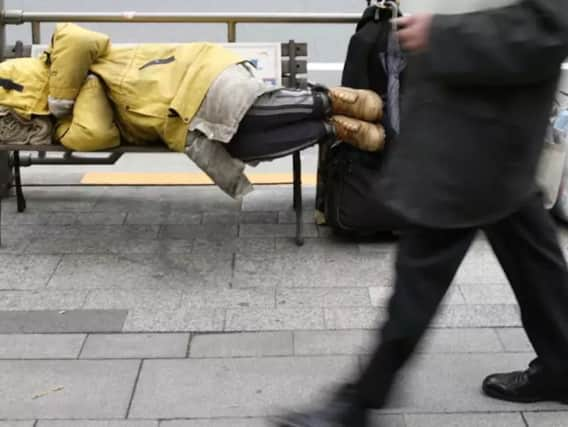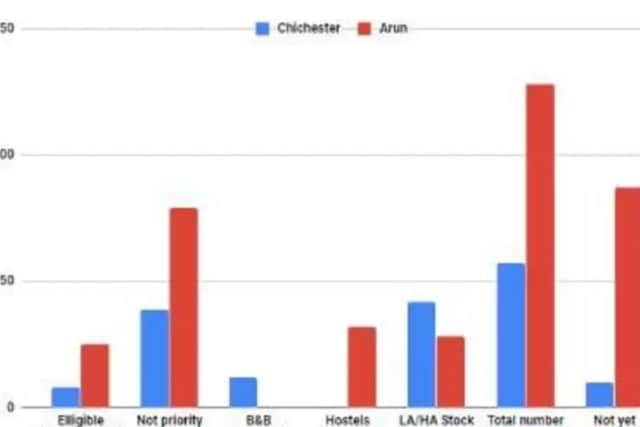Council pledges to reduce homelessness in Chichester


The figures, released by the Ministry of Housing, Communities and Local Government, show that in the South East, the total number of people currently living in temporary accommodation is 8,474 (up by 391 people from last year and 4,816 from 2010) and the total number of those living in B&Bs is 732.
Chichester breakdown
Focusing specifically on Chichester, a breakdown of the statistics (table 784)show that 57 people have been counted in temporary accommodation in 2017/18 compared to 35 in 2007/08, whilst 12 people have been living in B&Bs in 2017/18 compared to zero ten years ago.


Advertisement
Hide AdAdvertisement
Hide AdIn those ten years, the total number of ‘decisions’ made by the council involving people presenting as homeless has risen by 94 (84 to 178) and the number of people ‘not yet secured’ in accommodation has reduced by 28 from 38 to 10.
The number of homeless people per 1,000 households has reduced by just -0.01 in ten years (1.1 down to 1.09) and ten fewer people classed as ‘intentionally homeless’ are ‘eligible homeless and in priority need’ (18 down to 8), with 87 more people ‘eligible but not homeless’ (6 up to 93).Since last year, 25 more decisions have been made, 31 more people were ‘eligible but not homeless’ and just four more people were ‘not yet secured’, with 12 more people being put in temporary accommodation (45 up to 57).
In response to these findings, a Chichester District Council spokesman said: “We are committed to reducing homelessness in the district and we work with our partner agencies to help those who are homeless in our district get back on their feet. Changes to the Government’s homelessness policy means that we can now carry out more proactive work with potentially homeless people at an earlier stage.
“This will involve working with people on a one-to-one basis to look at all housing options, to ensure the correct benefits are being accessed as well as working with landlords. This includes helping people so they are able to remain in their existing accommodation, for example by negotiating with landlords or providing welfare benefit advice.
Advertisement
Hide AdAdvertisement
Hide Ad“We will also help households to access alternative accommodation, for example by providing help to access the private sector through our rent in advance and deposit scheme. We hope that this work will help to reduce the numbers of people who are homeless in the district.”
The spokesman said that last year it was announced the council would receive £275,000 over two years from the Government’s Flexible Homelessness Grant.
The spokesman added: “This has enabled us to create a Housing Welfare Officer post and an extra housing intervention posts.
“This year we received a further £188,000 for the year 2019 to 2020, which will help us to further increase our staffing resources by offering housing and welfare advice at an earlier stage, as required by the Government’s new Homelessness Reduction Act 2017, which was made law in April.
Advertisement
Hide AdAdvertisement
Hide Ad“We have also created a new rough sleeper outreach worker post which will focus on helping rough sleepers back into settled accommodation. The successful applicant is expected to be in post by the end of August.
“We have a duty to assist families or individuals who have been made homeless and in some circumstances to provide temporary accommodation. We have our own dedicated housing facility that is used for this purpose but when our accommodation is full, we have to use private rented accommodation, and in some cases bed and breakfast accommodation. We have recently acquired a building to enable us to expand our own temporary accommodation.”
The homelessness prevention and relief statistics show that the total number of people living in temporary accommodation in England is 79,880 (up three per cent from last year and 56 per cent from 2010) and the total number living in B&Bs is 5,940, a decrease of ten per cent from last year (6,580) but an increase of 190 per cent from 2010 (2,050).
Arun figures are higher but council has plans
The figures for Arun show there are significantly more homeless people than in Chichester (see pictured bar chart), but Arun District Council said it had plans in place to reduce this number.
Advertisement
Hide AdAdvertisement
Hide AdThere are 26 fewer people in temporary accommodation in 2017/18 in Arun than there were in 2007/08 (154 down to 128), zero B&Bs are being used (a decrease of one since 2008), and there were also five less hostels in use (37 down to 32).
Furthermore, six fewer people classed as ‘intentionally homeless’ are ‘eligible homeless and in priority need’(31 down to 25).
However, the total number of ‘decisions’ made by the council involving people presenting as homeless has risen by 308 over the last ten years (430 up to 738) and 95 more people are ‘eligible (for support) but not homeless’ (335 up to 430).
There has also been an increase of 83 people ‘not yet secured’ in accommodation (4 up to 87).
Advertisement
Hide AdAdvertisement
Hide AdThe number of homeless people per 1,000 households has also increased, with figures showing 0.9 people in 2007/8 compared to 1.79 in 2017/18 (up by 0.89).
Since last year, 33 fewer ‘decisions’ were made (771 down to 738) and 36 fewer people have been classed as ‘eligible but not homeless’ (466 down to 430).
However, 21 more people were ‘not yet secured’ (66 up to 87) and 41 more people in temporary accommodation (87 up to 128).
Responding to the findings, a spokesman for Arun District Council said: “Over the last ten years, nationally, there has been an increase in homelessness and the figures for Arun District Council reflect this trend.
Advertisement
Hide AdAdvertisement
Hide Ad“This can be attributed to national changes in social and welfare policy and the rising cost of housing across all tenures.
“The cost of living has increased and not kept pace with household incomes, along with rising housing costs. The current demand for social housing outstrips supply.
“As a council we are committed to preventing homelessness and have a new-build council housing programme to help alleviate homelessness.
“We have also recently acquired new temporary accommodation units to reduce the use of Bed and Breakfast facilities.”
Stonepillow outlines strategy
Advertisement
Hide AdAdvertisement
Hide AdFounded in 1989 and now in its 29th year of operation, the homeless charity Stonepillow has ‘expanded services across West Sussex’ and ‘offer shelter, information and support to empower homeless and vulnerable people to make positive changes in their lives’.
Laura Bulbeck, from the charity, said: “Currently, the two most common reasons for people accessing our services are family and relationship breakdown and loss of private accommodation.”
Stonepillow said it continues to adapt ‘ways of working to meet the changing needs of clients and the economic landscape’.
Outling the charity’s future plans, Stonepillow’s new chief executive, Hilary Bartle, said: “We are developing our five-year strategy, in consultation with clients, staff, volunteers and partners, to give clear direction for the future, which will be launched in 2019.
“We are committed to delivering services which meet the complex needs of those who are rough sleeping, homeless and vulnerably housed in Chichester, Bognor Regis and Littlehampton.”